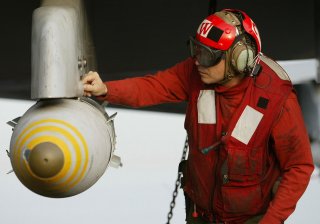Flying Naval Mines Could Change Naval Warfare Forever
Or is this another supposed game-changer that is going nowhere?
Like land mines, naval mines sit in wait for enemy traffic—not soldiers or tanks, but ships and submarines. These silent killers can be activated in a variety of ways, by direct physical contact, via magnetic detection, or by hearing moment in or on the water. Tedious and time consuming to disarm—they are low-cost and are used to cut off an enemy’s access to mined areas.
In recent years, the U.S. Navy has fielded the SLMM (Submarine-Launched Mobile Mine) as well as a 500, 1,000, and 2,000 pound Quickstrike mines. Like their land-based counterparts, naval mine technology is really old. Dr. George Ka’iliwai III, USINDOPACOM Director of Requirements and Resources told reporters that “current mine technology, while effective, has been largely unchanged since World War II.” But, Navy recently built something new.
Bombs Away
This new mine is actually an amalgamation of several other weapon systems onto one flight-capable mine platform. The Navy outfitted Quickstrike mines with the tail assembly from a JDAM-ER (Joint Direct Attack Munition—Extended Range), and a pop-out wing kit. Though unpowered, the gliding mine can fly quite a long distance, which increases with the height at which it is dropped.
In an USNI article, a naval official was asked about the future of naval mines, and said naval mine technology, “is changing big time. The Office of Naval Research has been involved in this for a while, and there are a lot of systems, Future Naval Capabilities, that are being tested.” The spokesman was a little short on details however, saying somewhat mysteriously, “the future of mining will be clandestinely launched mines. And that’s probably as much as I can say here.”
The Quickstrike-JDAM naval mine is apparently easy to assemble, and the parts are compatible with any Quickstrike or JDAM components in the U.S. military’s inventories. Speaking about the mines Dr. Ka’iliwai also explained that, “these innovations and capabilities in the QS-ER [Quickstrike-JDAM mine] project will allow our forces to generate more effective minefields from longer ranges and more rapidly than ever before.”
A senior Air Force Officer remarked on the QS-ER’s abilities, saying, “this effort [testing the QS-ER] marked the first advance in aerial mine delivery techniques since 1943,” He elaborated, saying the flight test, “demonstrated a capability that substantially changes the potential of aerial mining in a threat environment.”
Postscript
By delivering naval mines from longer stand-off distances, American bombers will be father from harm’s way and therefore better protected. As tensions increase world-wide, potential hotspots like the South China Sea or the Persian Gulf may be places with potential for flying American mines. Enemies beware.
Caleb Larson holds a Master of Public Policy degree from the Willy Brandt School of Public Policy. He lives in Berlin and writes on U.S. and Russian foreign and defense policy, German politics, and culture.
Image: Reuters

